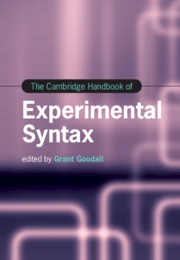Book contents
- The Cambridge Handbook of Experimental Syntax
- The Cambridge Handbook of Experimental Syntax
- Copyright page
- Contents
- Figures
- Tables
- Contributors
- Introduction
- Part I General Issues in Acceptability Experiments
- Part II Experimental Studies of Specific Phenomena
- Part III Experimental Studies of Specific Populations and Language Families
- 14 Acceptability Studies in L2 Populations
- 15 Judgments of Acceptability, Truth, and Felicity in Child Language
- 16 Acceptability and Truth-Value Judgment Studies in East Asian Languages
- 17 Acceptability Experiments in Romance Languages
- 18 Acceptability Studies in (Non-English) Germanic Languages
- 19 Acceptability Studies in Semitic Languages
- 20 Experimental Syntax and Slavic Languages
- 21 Acceptability Judgments in Sign Linguistics
- Part IV Experimental Syntax beyond Acceptability
- Index
- References
20 - Experimental Syntax and Slavic Languages
from Part III - Experimental Studies of Specific Populations and Language Families
Published online by Cambridge University Press: 16 December 2021
- The Cambridge Handbook of Experimental Syntax
- The Cambridge Handbook of Experimental Syntax
- Copyright page
- Contents
- Figures
- Tables
- Contributors
- Introduction
- Part I General Issues in Acceptability Experiments
- Part II Experimental Studies of Specific Phenomena
- Part III Experimental Studies of Specific Populations and Language Families
- 14 Acceptability Studies in L2 Populations
- 15 Judgments of Acceptability, Truth, and Felicity in Child Language
- 16 Acceptability and Truth-Value Judgment Studies in East Asian Languages
- 17 Acceptability Experiments in Romance Languages
- 18 Acceptability Studies in (Non-English) Germanic Languages
- 19 Acceptability Studies in Semitic Languages
- 20 Experimental Syntax and Slavic Languages
- 21 Acceptability Judgments in Sign Linguistics
- Part IV Experimental Syntax beyond Acceptability
- Index
- References
Summary
The chapter reviews a number of empirical domains that recently came into the focus of research in Slavic experimental syntax, including island phenomena, syntactic Superiority effects, various types of agreement, word order, and scope interaction, among others. This research mostly relies on sentence acceptability experiments applied across larger pools of participants, but the chapter also reviews selected studies using related experimental methods (e.g. elicited production and sentence–picture verification). The chapter concludes by identifying a number of conceptual issues in syntactic theory, for which we believe Slavic experimental syntax has a potential to make a particularly strong contribution.
Keywords
- Type
- Chapter
- Information
- The Cambridge Handbook of Experimental Syntax , pp. 534 - 560Publisher: Cambridge University PressPrint publication year: 2021



